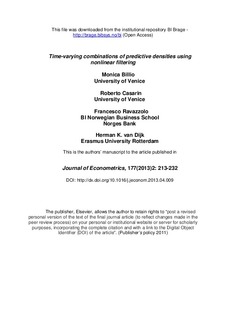Time-varying combinations of predictive densities using nonlinear filtering
Journal article, Peer reviewed
Permanent lenke
http://hdl.handle.net/11250/93780Utgivelsesdato
2013Metadata
Vis full innførselSamlinger
- Scientific articles [2181]
Originalversjon
10.1016/j.jeconom.2013.04.009Sammendrag
We propose a Bayesian combination approach for multivariate predictive densities which relies upon a distributional state space representation of the combination weights. Several speci cations of multivariate time-varying weights are introduced with a particular focus on weight dynamics driven by the past performance of the predictive densities and the use of learning mechanisms. In the proposed approach the model set can be incomplete, meaning that all models can be individually misspeci ed. A Sequential Monte Carlo method is proposed to approximate the ltering and predictive densities. The combination approach is assessed using statistical and utility-based performance measures for evaluating density forecasts of simulated data, US macroeconomic time series and surveys of stock market prices. Simulation results indicate that, for a set of linear autoregressive models, the combination strategy is successful in selecting, with probability close to one, the true model when the model set is complete and it is able to detect parameter instability when the model set includes the true model that has generated subsamples of data. Also, substantial uncertainty appears in the weights when predictors are similar; residual uncertainty reduces when the model set is complete; and learning reduces this uncertainty. For the macro series we nd that incompleteness of the models is relatively large in the 70's, the beginning of the 80's and during the recent nancial crisis, and lower during the Great Moderation; the predicted probabilities of recession accurately compare with the NBER business cycle dating; model weights have substantial uncertainty attached. With respect to returns of the S&P 500 series, we nd that an investment strategy using a combination of predictions from professional forecasters and from a white noise model puts more weight on the white noise model in the beginning of the 90's and switches to giving more weight to the professional forecasts over time. Information on the complete predictive distribution and not just on some moments turns out to be very important, above all during turbulent times such as the recent nancial crisis. More generally, the proposed distributional state space representation o ers a great exibility in combining densities.
Beskrivelse
This is the authors’ manuscript to the article also published at http://www.ssrn.com/
